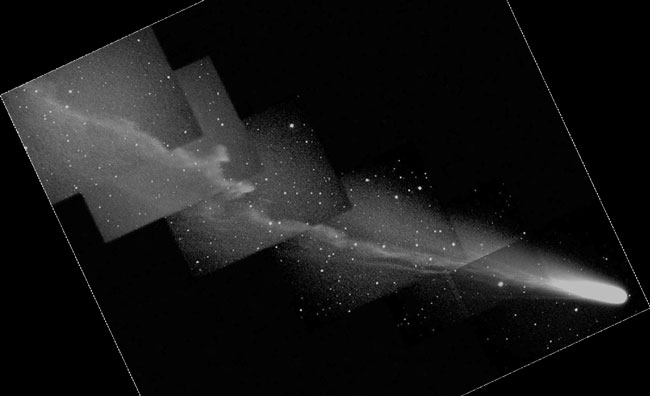Credit & Copyright: Gilbert Jones
Explanation:
One of the brightest comets of the past five years
will likely reach its peak brightness this week.
Comet Ikeya-Zhang, officially known as C/2002 C1,
can now be seen without aide from a dark location
above the western horizon shortly after sunset.
Recent
luminosity estimates for
Comet Ikeya-Zhang place it between magnitudes three and four, making it brighter
than most commonly visible stars.
The above picture was taken on March 11 near Tucson,
Arizona,
USA.
The image caught
Comet Ikeya-Zhang showing a quite detailed
ion tail, possibly
disrupted by the
magnetic field of the
Sun's
outwardly flowing
particle wind.
As the activity of comets is notoriously hard to predict,
Comet Ikeya-Zhang may still hold some surprises as it
rounds the Sun this month and starts back out of the
Solar System in April.
1999 2000 2001 2002 2003 2004 2005 2006 2007 2008 2009 2010 2011 2012 2013 2014 2015 2016 2017 2018 2019 2020 2021 2022 2023 2024 2025 |
Yanvar' Fevral' Mart Aprel' Mai Iyun' Iyul' Avgust Sentyabr' Oktyabr' Noyabr' Dekabr' |
NASA Web Site Statements, Warnings, and Disclaimers
NASA Official: Jay Norris. Specific rights apply.
A service of: LHEA at NASA / GSFC
& Michigan Tech. U.
|
Publikacii s klyuchevymi slovami:
comet Ikeya-Zhang - tail - kometa Ikeya-Zhanga
Publikacii so slovami: comet Ikeya-Zhang - tail - kometa Ikeya-Zhanga | |
Sm. takzhe:
Vse publikacii na tu zhe temu >> | |
